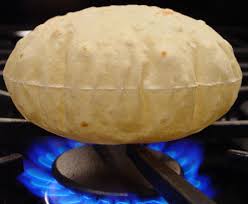It is a well-researched subject -
the connection between smell and memory. It is believed that the olfactory bulb is a part of the brain's limbic system, which is closely associated with memories and that is the reason why smells are associated with certain memories. I have been credited with having a keen sense of smell, almost akin to that of a dog-which if I was not such a die hard dog lover, would have been insulting. But it is true, I am very sensitive to smell. I do not mean that even slightly strong odours upset me. On the contrary, I have quite a high tolerance for noxious odors. I am senstive to the good kind of smells. You know how the advertisements claim the sweet scent of the soaps can tranport you to a tropical paradise or the lavender oil can instantly calm your stresses - well, it sure works on me! And the most memorable smells of all are that of food. I remember telling my mother after coming home from school one day that I could smell tandoori chicken while I was in the class! Today there are some memories so strongly intertwined with smells tha t even though I am far away from the places where these events/memories happened, for that instant i get a surge of familiarity rushing through my senses that takes me to a very special place.
t even though I am far away from the places where these events/memories happened, for that instant i get a surge of familiarity rushing through my senses that takes me to a very special place. My favorite food smell is that of frreshly made rotis - unleavened Indian bread, being puffed over the open flame. That for me is the smell of my mother's kitchen. Throughout my growing up years, when I finally got interested in the kitchen (much to my mothers relief) the thing that amazed me the most was how my mother would make perfectly round, evenly puffed rotis, day in and day out, as if traced with the back of a bowl or made in a mould. It took me years to perfect this craft and even though most of the times my rotis do turn out round and evenly puffed, they still cannot rival my mother's. The earthy scent of wheat getting roasted over open fire is as close to nature as you can get, sitting in your dining room.
Another very strong scent that floods the oxytocin receptors in my brain is that of warm ghee - clarified butter. If you think the smell of butter is irresistable, wait till you get a waft of this heavenly perfume, when ghee is pured over anything hot - usually steaming rice or when put in a hot pot to be used for cooking, like my ajji (grandmother) used to do. She didnot let the minor fact that ghee is 100% fat, free of all annoying milk solids, ever get in the way of her cooking. Ghee was (and still is) a mandatory addition to most of her dishes. But the one dish which I absolutely devour and one that cannot be replicated is her Kadhi - a hot soup usually used as an accompaniment to the main course; made up of yogurt and gram flour, flavoured with green chillies, ginger, cilantro and tempered with hot ghee, cumin seeds and curry leaves. The smell of cumin seeds sputtering away in hot ghee is the stuff of my childhood dreams!!
A scent I was introduced to after coming to America was that of vanilla...ummm..just the mention of the name brings to my mind visions of perfectly kept, beautiful houses or quaint boutiques with candles and glasswares in tiny town of the West. Yes, even though this is a food fragrance, my immediate memory associated with vanilla is our first attempt at house hunting in California and innumerable visits to the model houses. Since then I have lived in a number of houses and have never ever achieved that level of vanilla-scentedness, no matter how many candles or chemicals I have burned.
The memories are innumerable. The whiff of teriyaki chicken being grilled outdoors on cold, fall saturday mornings in the Strip district of Pittsburgh, the magical essence of lavender oils floating through the streets of Ojai, CA or the pure unadulterated fishy ocean smell of the Hawaiian coast - every memorable experience has a smell to it. I realized I was helping my son form his own memories when, on sniffing a handful of fresh basil leaves, he remarked, "Oh this is the smell of the pasta from yesterday!!"
Kadhi
1/4 cup Low-fat Greek yogurt
2 tbsp gram flour (besan)
1 cup water
2 tsp ghee or butter
1 tsp cumin seeds
1/2 tsp turmeric
1 tsp salt
1 tsp grated ginger
1/2 serrano/jalapeno chilly seeded and chopped
5-6 curry leaves torn
handful of chopped fresh cilantro
In a bowl, whisk together yogurt, water ginger, turmeric and salt. To it, add the gram flour slowly and mix it well. Whisk it well and break up any lumps that may form. Add the chillies (if using). In a thick-bottomed sauce pan, heat the ghee or butter over low heat. Add the cumin seeds when the butter melts. When the seeds start to crackle, add the curry leaves. To this add the yogurt mixture, making sure that the heat is turned down to low to medium low. Stir the mixture and let it come to a slow boil. Do not let the mixture thicken. You will need to add more water, upto 1 cup to keep the consistency of the soup. Cook over low heat for 1-2 minutes. Add the cilantro leaves and serve hot as soup or as a side dish with steaming white rice.
Gram flour or besan is found very commonly in Indian grocery stores. It is light yellow in colour and smells of chick peas.
